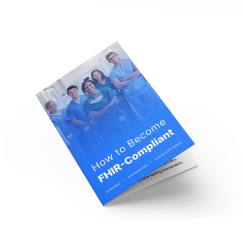FHIR implementation is a relatively recent trend in the healthcare industry. Even though many providers have already adopted FHIR to ensure interoperability, use cases are limited. Thus, if someone who has never built interoperable systems tries to do it, they can make terrible mistakes.
A FHIR implementation plan is a way to achieve software interoperability smoothly. It gives you a product roadmap and an understanding of the steps you need to take. Besides, if you lack expertise for FHIR implementation planning, you can hire a third-party agency like Binariks. We will create a personalized plan for your company and assist with putting it into effect.
Read more about HL7 FHIR implementation and find helpful guidelines in this post.
What's FHIR?
FHIR, or Fast Healthcare Interoperability Resources, is an emerging HL7 standard that describes data formats, resources, and APIs required for easy exchange of electronic health records (EHR). It builds on previous data standards by HL7, including V2, V3, and CDA, but supports a wider variety of formats. Since it leverages modern API technology, including an HTTP-based RESTful protocol, FHIR is also easier to implement than other standards.
The main goal of FHIR is to facilitate the integration of healthcare applications, smart devices, and software through interoperability. It's intended to help developers build systems that are highly compatible and easy to scale. Apart from that, FHIR also significantly improves the quality of care and health research thanks to simplified big data management.
We have a guide that explains everything you should know about FHIR. Check out the article on the FHIR standard for more details.
FHIR implementation use cases
First, according to the 21st Century Cures Act, FHIR compliance is mandatory for any healthcare provider serving Medicare and Medicaid patients. Yet other organizations can also considerably benefit from it.
Not sure whether FHIR implementation in healthcare relates to you? Common use cases can guide you and show how FHIR adoption can take a business to a new level.
Generally, FHIR is used for:
- Creating all-in-one patient portals available across apps and devices
- Sharing medical charts and related documentation necessary to process insurance claims
- Providing teams with access to personal health records for collaboration and enhanced care
- Using cloud and AI technologies to build solutions with predictive analytics and automation
- Designing decision support applications (e.g., patient surveillance for early warning of possible health issues, software to identify candidates for alternative treatment plans, etc.)
Let's discuss specific FHIR implementation use cases in more depth to see how it works:
Automation of e-referrals
The healthcare software provider needed to integrate its cloud platform with numerous EHR software providers, hospitals, and physicians. Since it was subject to the 21st Century Cures Act, meeting FHIR specifications was essential. Apart from regulatory compliance, FHIR was necessary to standardize health data and ensure its secure exchange for automated e-referral generation.
HL7 FHIR adoption allowed the platform provider to optimize the work of general practitioners, primary care physicians, and medical office managers. It enabled e-referring between various electronic health records to automate routine patient management tasks.
Case Study
Revamping Solution Architecture and Enabling Interoperability on Healthcare Referral Platform
Staff performance optimization
A US health system had staffing problems as it lacked dermatologists to cover the demand. Because of the shortage, primary care physicians were forced to perform dermatology exams. It affected their efficiency and quality of care as the PCPs didn't have experience with skin issues and treatment.
An FHIR-powered app connected to an EHR system solved the problem. The provider powered its staff with the application that facilitates decision-making for doctors, including dermatologists. It leverages medical imaging, health data visualization , and machine learning to generate possible diagnoses based on data. With this tool, the accuracy of diagnoses and the performance of the PCPs significantly improved.
Want to become HIPAA-compliant?
Learn about best practices of FHIR implementation.

FHIR implementation plan
FHIR specification implementation always requires a custom approach. A universal plan suitable for all organizations doesn't exist since every healthcare provider is unique. Once you start working on interoperability adoption, you will need to study your system requirements. Only based on this information can you develop a proper implementation guide.
The steps below reflect the most common stages of FHIR planning and implementation. Your custom plan will include most of them.
Explore FHIR resources
Start with gathering information about the standard you implement. Although FHIR is still new, you can find many valuable resources on the web. They explain who must meet the standard and what specifications matter.
Here are some valuable resources the CDC agency provides:
- The official HL7 FHIR page: https://hl7.org/fhir/
- Cures Act Final Rule webinars: https://www.healthit.gov/curesrule/resources/webinars
- Guidance for FHIR implementation guide creation: https://build.fhir.org/ig/FHIR/ig-guidance/best-practice.html
- Cures Act Final Rule fact sheets: https://www.healthit.gov/curesrule/resources/fact-sheets
- Getting Started With FHIR: https://hl7.org/fhir/modules.html
- HL7 GitHub Web page: https://github.com/CDCgov
- EPIC HL7 FHIR Tutorial: https://fhir.epic.com/Documentation?docId=fhir
- Cerner SMART on FHIR Tutorial: https://engineering.cerner.com/smart-on-fhirtutorial/#introduction
Gather requirements and do pre-planning
Once you learn more about FHIR and can relate its implementation to your business needs, it's time to do pre-planning.
Identify the community of interest (COI) – the experts that will help you map FHIR adoption and have the necessary knowledge. If you don't have them in-house, you may outsource the process to a third-party proficient in healthcare interoperability standards.
At this point, it's also necessary to:
- Identify health IT system types and their roles
- Describe scenarios or workflows that define how information exchanges are triggered
- Indicate the information exchange and acceptance criteria for each software use case
- Identify the mandatory input and output data elements for each information exchange
- Figure out whether you can derive data from existing workflows or need custom data collection
- Decide how you will measure the quality of interoperability
Requirement gathering allows you to understand the core data use cases in your systems. This information will simplify FHIR adoption as you will understand how to update existing data processing practices and connect apps efficiently.
Prepare for implementation and estimate the impact
After you know the requirements, you can make more detailed planning for FHIR server implementation. It will allow you to estimate expenses and set KPIs.
In particular, you need to determine the cost of HL7 adoption for a specific organization. Although the FHIR standard and all related resources are free to use, transition to more advanced systems requires investment. You may need to hire software engineers with the necessary skills, pay for additional data storage, connect new paid apps, etc. Mind that system support also requires continuous investment. So be sure to evaluate your budget beforehand.
Even if you primarily follow FHIR requirements for regulatory compliance, optimization can supercharge your business. The enhanced performance and better care make interoperability pay off in the long run. Thus, initial estimates are also necessary to measure the impact of the implemented changes.
Initiate a project
At this point, you should have a clear roadmap for FHIR specification adoption. You already know your existing data processing workflows and realize how to change them through API integrations. You also have an implementation guide and documentation describing data uses.
Most importantly, you have assembled a team of software engineers and other specialists with expertise in FHIR. Or, you may have outsourced the process to a third-party partner like Binariks, which basically means you have a dedicated team for your project.
Now, it's time to start the transition to FHIR and introduce all the necessary modifications to your system.
Test how it works
In the course of changes, you will need to test data exchange workflows across your system. Patient information must be available to all entitled parties across apps and devices.
Testing is crucial to detect and promptly fix any issues that are sure to happen since FHIR implementation is a complex process.
How Binariks can help implement FHIR standard
Binariks is a software development company focusing on healthcare interoperability solutions. We hire software engineers with prior experience adopting HL7 standards, including FHIR. They can assist you with a specific task or take full responsibility for the project. You choose the scope of involvement and services.
Overall, Binariks can:
- Consult you on how to achieve FHIR interoperability after analyzing your existing system
- Outstaff our engineers to assist with practical tasks like optimization or integration
- Assemble a dedicated team for you that will help build interoperable systems from scratch
Read more about our completed projects
Final thoughts
FHIR implementation is always a custom story. Hence, if you need a plan to adopt it, be ready for profound business research. You must analyze your current data exchange practices to understand how to adapt them to the FHIR requirements. Only based on these findings can you develop an implementation guide with use cases.
Given the scope of work, interoperability adoption may be challenging if you haven't done it before. Fortunately, you can outsource this task to a third-party provider like Binariks. It saves you time, nerves, and resources.
FAQ
Share

